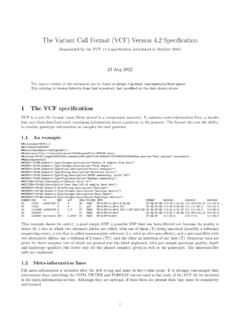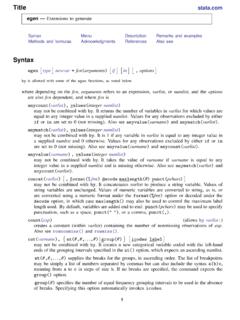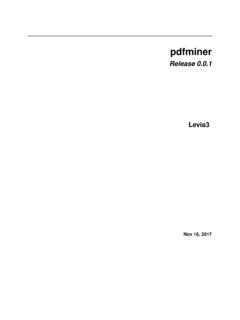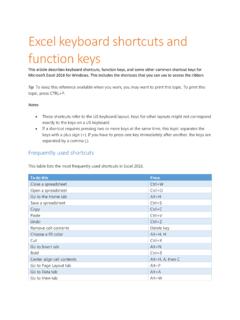Transcription of The Variant Call Format (VCF) Version 4.2 Specification
1 The Variant Call Format (VCF) Version Specification (Superseded by the VCF Specification introduced in October 2015)23 Aug 2022 The master Version of this document can be found printing is Version 6a6e44a from that repository, last modified on the date shown The VCF specificationVCF is a text file Format (most likely stored in a compressed manner). It contains meta-information lines, a headerline, and then data lines each containing information about a position in the genome. The Format also has the abilityto contain genotype information on samples for each An example##fileformat= ##fileDate=20090805##source= ##reference=file:///seq/ ##contig=<ID=20,length=62435964,assembly=B36,md5=f126cdf8a6e0c7f379d618ff66beb2da,species="Homo sapiens",taxonomy=x>##phasing=partial##INFO=<ID=NS,Number=1,Type=Integer,Description="Number of Samples With Data">##INFO=<ID=DP,Number=1,Type=Integer,Description="Total Depth">##INFO=<ID=AF,Number=A,Type=Float,Description="Allele Frequency">##INFO=<ID=AA,Number=1,Type=String,Description="Ancestral Allele">##INFO=<ID=DB,Number=0,Type=Flag,Description="dbSNP membership, build 129">##INFO=<ID=H2,Number=0,Type=Flag,Description="HapMap2 membership">##FILTER=<ID=q10,Description="Quality below 10">##FILTER=<ID=s50.
2 Description="Less than 50% of samples have data">## Format =<ID=GT,Number=1,Type=String,Description="Genotype">## Format =<ID=GQ,Number=1,Type=Integer,Description="Genotype Quality">## Format =<ID=DP,Number=1,Type=Integer,Description="Read Depth">## Format =<ID=HQ,Number=2,Type=Integer,Description="Haplotype Quality">#CHROM POS ID REF ALT QUAL FILTER INFO Format NA00001 NA00002 NA0000320 14370 rs6054257 G A 29 PASS NS=3;DP=14;AF= ;DB;H2 GT:GQ:DP:HQ 0|0:48:1:51,51 1|0:48:8:51,51 1/1:43:5:.,.20 17330 . T A 3 q10 NS=3;DP=11;AF= GT:GQ:DP:HQ 0|0:49:3:58,50 0|1:3:5:65,3 0/0:41:320 1110696 rs6040355 A G,T 67 PASS NS=2;DP=10;AF= , ;AA=T;DB GT:GQ:DP:HQ 1|2:21:6:23,27 2|1:2:0:18,2 2/2:35:420 1230237.
3 T . 47 PASS NS=3;DP=13;AA=T GT:GQ:DP:HQ 0|0:54:7:56,60 0|0:48:4:51,51 0/0:61:220 1234567 microsat1 GTC G,GTCT 50 PASS NS=3;DP=9;AA=G GT:GQ:DP 0/1:35:4 0/2:17:2 1/1:40:3 This example shows (in order): a good simple SNP, a possible SNP that has been filtered out because its quality isbelow 10, a site at which two alternate alleles are called, with one of them (T) being ancestral (possibly a referencesequencing error), a site that is called monomorphic reference ( with no alternate alleles), and a microsatellite withtwo alternative alleles, one a deletion of 2 bases (TC), and the other an insertion of one base (T).
4 Genotype data aregiven for three samples, two of which are phased and the third unphased, with per sample genotype quality, depthand haplotype qualities (the latter only for the phased samples) given as well as the genotypes. The microsatellitecalls are Meta-information linesFile meta-information is included after the ## string and must be key= value pairs. It is strongly encouraged thatinformation lines describing the INFO, FILTER and Format entries used in the body of the VCF file be includedin the meta-information section. Although they are optional, if these lines are present then they must be File formatA single fileformat field is always required, must be the first line in the file, and details the VCF Format versionnumber.
5 For example, for VCF Version , this line should read:##fileformat= Information field formatINFO fields should be described as follows (first four keys are required, source and Version are recommended):##INFO=<ID=ID,Number=number,Type=type,Description="description",Source="source", Version =" Version ">Possible Types for INFO fields are: Integer, Float, Flag, Character, and String. The Number entry is an Integerthat describes the number of values that can be included with the INFO field. For example, if the INFO field containsa single number, then this value should be 1; if the INFO field describes a pair of numbers, then this value shouldbe 2 and so on. There are also certain special characters used to define special cases: If the field has one value per alternate allele then this value should be A.
6 If the field has one value for each possible allele (including the reference), then this value should be R . If the field has one value for each possible genotype (more relevant to the Format tags) then this valueshould be G . If the number of possible values varies, is unknown, or is unbounded, then this value should be ..The Flag type indicates that the INFO field does not contain a value entry, and hence the Number should be0 in this case. The Description value must be surrounded by double-quotes. Double-quote character can be escapedwith backslash\and backslash as\\. Source and Version values likewise should be surrounded by double-quotesand specify the annotation source (case-insensitive, dbsnp ) and exact Version ( 138 ), respectively forcomputational Filter field formatFILTERs that have been applied to the data should be described as follows:##FILTER=<ID=ID,Description="description"> Individual Format field formatLikewise, Genotype fields specified in the Format field should be described as follows:## Format =<ID=ID,Number=number,Type=type,Description="description">Possible Types for Format fields are.
7 Integer, Float, Character, and String (this field is otherwise definedprecisely as the INFO field). Alternative allele field formatSymbolic alternate alleles for imprecise structural variants:##ALT=<ID=type,Description="description">The ID field indicates the type of structural Variant , and can be a colon- separated list of types and subtypes. IDvalues are case sensitive strings and may not contain whitespace or angle brackets. The first level type must be oneof the following: DEL Deletion relative to the reference INS Insertion of novel sequence relative to the reference DUP Region of elevated copy number relative to the reference2 INV Inversion of reference sequence CNV Copy number variable region (may be both deletion and duplication)The CNV category should not be used when a more specific category can be applied.
8 Reserved subtypes include: DUP:TANDEM Tandem duplication DEL:ME Deletion of mobile element relative to the reference INS:ME Insertion of a mobile element relative to the referenceIn addition, it is highly recommended (but not required) that the header include tags describing the referenceand contigs backing the data contained in the file. These tags are based on the SQ field from the SAM spec; all tagsare optional (see the VCF example above).For all of the ##INFO, ## Format , ##FILTER, and ##ALT metainformation, extra fields can be includedafter the default fields. For example:##INFO=<ID=ID,Number=number,Type=type,Description="description",Source="description", Version ="128">In the above example, the extra fields of Source and Version are provided.
9 Optional fields should be stored asstrings even for numeric Assembly field formatBreakpoint assemblies for structural variations may use an external file:##assembly=urlThe URL field specifies the location of a fasta file containing breakpoint assemblies referenced in the VCF recordsfor structural variants via the BKPTID INFO Contig field formatAs with chromosomal sequences it is highly recommended (but not required) that the header include tags describingthe contigs referred to in the VCF file. This furthermore allows these contigs to come from different files. The formatis identical to that of a reference sequence, but with an additional URL tag to indicate where that sequence can befound.
10 For example:.##contig=<ID=ctg1,URL= ,..> Sample field formatIt is possible to define sample to genome mappings as shown below:##SAMPLE=<ID=S_ID,Genomes=G1_ID;G2_ID; ..;GK_ID,Mixture=N1;N2; ..;NK,Description=S1;S2; ..;SK> Pedigree field formatIt is possible to record relationships between genomes using the following syntax:##PEDIGREE=<Name_0=G0-ID,Name_1=G1-ID,..,Name_N=GN-ID>or a link to a database:##pedigreeDB= Header line syntaxThe header line names the 8 fixed, mandatory columns. These columns are as follows:1. #CHROM2. POS3. ID4. REF5. ALT6. QUAL7. FILTER8. INFOIf genotype data is present in the file, these are followed by a Format column header, then an arbitrary numberof sample IDs.









